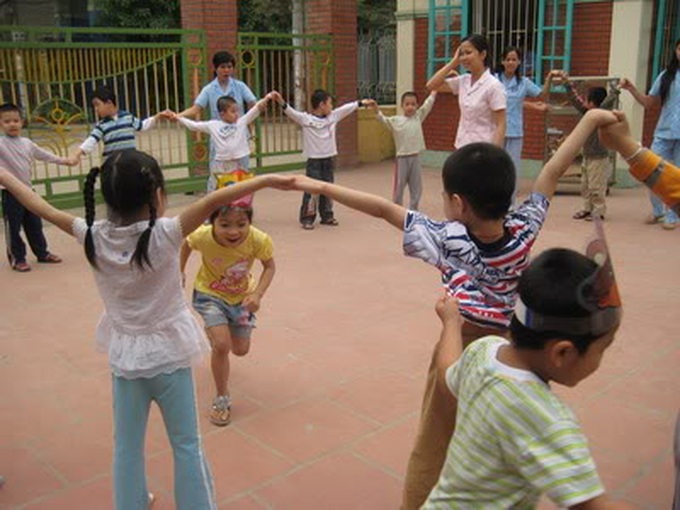Folk games, which used to be widely-known and considered a part of Vietnamese culture, have been fading out, in favour of more high-tech games.
In earlier days it was quite common to see children play simple games that required only sticks of bamboo or a rope. However games such as (Đánh chuyền), jump rope, “cat chases mouse” (Mèo đuổi chuột) or “blind-man's-buff” (Bịt mắt bắt dê) have been falling out of favour among the younger generation. This is despite the fact that many older people consider them to be good exercise and inexpensive.

"Cat chases mouse"
“Đánh chuyền” is one example - a game for girls in groups of 2-5. Each has a set of 10 small bamboo sticks and a round object, often just a fruit of vegetable. After throwing the object into the air, the children race to pick up the sticks. If one succeeds in picking up all ten, they will advance to the next round, with each stage requiring a higher number of sticks to be picked up at the same time, until the final round in which all of them must be grabbed.
This particular game is often accompanied by a song that is sung by the players and watchers, which changes for each round.
Many older people remember such games fondly, saying that the skills required are good for health and instill a sense of Vietnamese identity and pride. Many of them also include the singing of songs.
One 30-year old woman, Nguyen Bich Thuy, from Hanoi, fondly remembered such games from her childhood, saying, "I remember playing things like 'hide and seek' (Trốn tìm), or 'cat chases mouse' in summer evenings under the moonlight. But now I hardly ever see kids playing these games."
From low to high-tech
In modern times, however, kids have increasingly turned to high-tech games that require expensive devices, forgetting the old folk games.
Most of these games do not involve actual interaction with other children, which has raised a question over their social health. Some have even said that this could be a factor in the rising rates in autism.
It has been widely reported in the Vietnamese press that young people can become addicted to video games, leaving their studies and even their personal development behind. Whether or not this can be called an addiction has not been confirmed by the medical community, but even to the untrained eyes of parents this could be a worrisome trend.
The fact that so many internet shops are situated close to schools has already attracted much attention from the media.
Anecdotal evidence seems to back this up, with a rising number of parents like Mrs. Nguyen Cam Trang, of Tu Liem District, who said, "This new media scares me. My five-year old son watches characters like Spiderman, Ben Ten and Deka. He told me that all his friends have t-shirts and backpacks advertising these characters."
When she bought him a backpack with a picture of a bird, he was disappointed and insisted on something like his friends had.
She said, however, "When he sees these types of characters in action, he will imitate them, often using violence against his sister, or even me and my husband as if he were Superman."
Efforts to promote folk games in schools
The Ministry of Education and Training has launched an informational campaign to promote more folk games at schools. The ministry joined hands with Vietnam Museum of Ethnology to hold a training courses for teachers from boarding schools in mountainous areas to teach folk games to their students again.
Over the past five years, around 10 schools have co-operated with the museum to organise folk games for their students, including many in Hanoi. Some international schools have also shown interest, such as France’s Alexandre Yersin, which holds six days to introduce folk toy production processes to children every month at the museum.
Many parents have also started to take their children to the museum to play the same games they did as children in order to reinforce a sense of national identity.




















